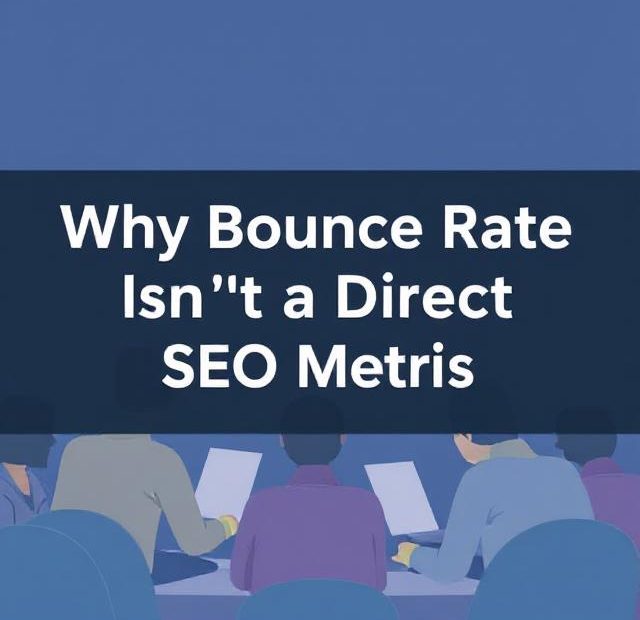For years, digital marketers and website owners have obsessed over bounce rate—the percentage of visitors who leave a website after viewing only one page. A high bounce rate is often seen as a bad sign, implying your content isn’t engaging, your design is poor, or your site isn’t delivering value. Because of this, many have assumed that bounce rate is a key ranking factor in Google’s search algorithm.
But here’s the reality: bounce rate is not a direct SEO ranking factor.
In this article, we’ll explain why Google doesn’t use bounce rate directly to determine rankings, the confusion that caused this myth to grow, and how you can interpret bounce rate in a more meaningful, productive way.
What Is Bounce Rate?
Bounce rate refers to the percentage of website visitors who land on a page and then leave without clicking on anything else or navigating to another page.
For example, if 100 people visit your blog post and 70 leave without exploring other content, your bounce rate is 70%.
Bounce rate is a metric tracked in tools like Google Analytics. It’s useful for measuring user behavior, but it’s often misunderstood.
The Myth: Bounce Rate Affects SEO Directly
Many marketers assume that a high bounce rate signals to Google that a page is low quality or irrelevant—therefore, Google should rank it lower. Conversely, a low bounce rate might indicate that visitors find the content valuable and are sticking around.
At face value, this seems reasonable.
But Google has consistently stated that bounce rate is not a signal used directly in its search ranking algorithms. While user behavior is important, bounce rate specifically is not a reliable or accurate measure of quality from Google’s perspective.
What Google Has Said
Google representatives, including John Mueller, have publicly addressed this topic multiple times. In a Twitter response, Mueller said:
“I think there’s a bit too much focus on bounce rate. It’s not something we use for search, so I wouldn’t focus on it too much for SEO.”
Why? Because bounce rate can be misleading.
A bounce could mean a user didn’t like the content—but it could also mean the content was so effective that the user got exactly what they needed without needing to click anywhere else.
Why Bounce Rate Doesn’t Make Sense as a Ranking Signal
There are several reasons why Google avoids using bounce rate directly in its ranking algorithms:
1. Ambiguity of Intent
One person might bounce because they didn’t find what they were looking for. Another might bounce because they got the exact answer they needed in 10 seconds. Google’s systems can’t (and shouldn’t) assume that a bounce is always negative.
2. Inconsistent Across Industries
Different websites naturally have different bounce rates. A single-page landing site, a recipe blog, or a news article will generally have higher bounce rates than an e-commerce store or interactive app.
3. Easily Manipulated
Because bounce rate is tied to user behavior, it’s relatively easy to manipulate. You could add fake page loads or redirect users unnecessarily to reduce the rate artificially. Google prefers to rely on signals that are harder to game.
What Google Does Pay Attention To
Although bounce rate isn’t a direct signal, Google does consider some user interaction signals, including:
-
Dwell time: The amount of time a user spends on a page before returning to the search results.
-
Click-through rate (CTR): How often users click your result when it’s shown in search.
-
Pogo-sticking: When a user quickly returns to the search results and clicks on another result, it may indicate dissatisfaction.
These metrics give a more nuanced picture of user satisfaction than bounce rate alone.
When Bounce Rate Can Still Be Useful
Even though it’s not a ranking signal, bounce rate can still offer valuable insights—if interpreted correctly.
✅ Content Relevance
If a specific blog post has a bounce rate of 90% while others on your site average 50%, it could mean that the content isn’t meeting users’ expectations or is poorly targeted.
✅ Page Load Speed & Mobile UX
A sudden spike in bounce rate after a site redesign or technical update might signal problems with load speed, broken links, or a frustrating mobile experience.
✅ Misaligned Traffic
If you’re running paid ads or social media campaigns and notice a high bounce rate, it could mean your messaging is attracting the wrong audience.
In these contexts, bounce rate can help diagnose issues—but it’s still not an indicator that Google will penalize your site.
How to Use Bounce Rate Productively
Instead of obsessing over the number, use bounce rate in combination with other metrics to build a clearer picture of user engagement:
-
Look at time on page alongside bounce rate to understand whether users are reading your content.
-
Use event tracking (such as video plays or downloads) to monitor on-page interaction.
-
Analyze traffic sources to see where high-bounce visitors are coming from—and whether they’re relevant.
-
Set goals in Google Analytics (like form submissions or clicks) to track meaningful user actions beyond just page views.
The more data you have, the better your optimization decisions will be.
Final Thoughts
So, let’s make it clear: bounce rate is not a direct SEO metric. It’s not part of Google’s ranking formula and shouldn’t be your main concern if you’re aiming to improve your search visibility.
Instead of fixating on bounce rate, focus on:
-
Creating content that satisfies user intent
-
Improving your site’s speed and usability
-
Matching the right traffic to the right pages
-
Measuring engagement in context with other signals
By doing so, you’ll create a better experience for your visitors—and in the process, improve your SEO in ways that do move the needle.
Also, you can learn more about Domain Age here.
